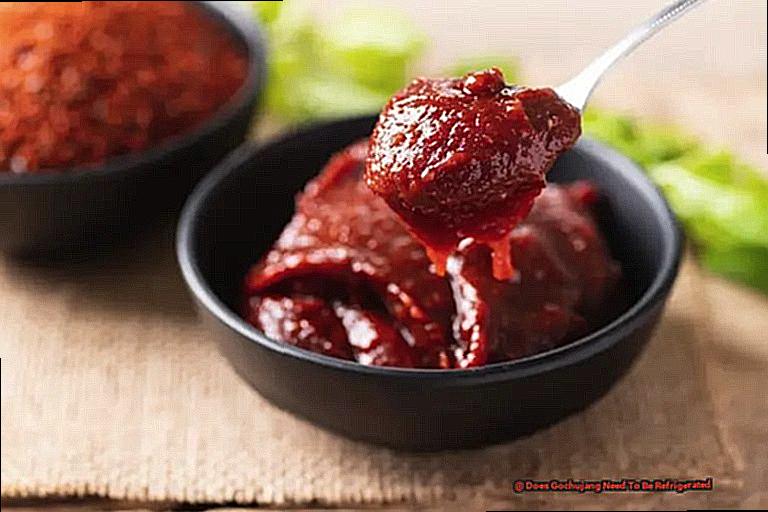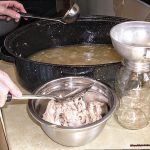Are you a lover of Korean cuisine? If so, then you’ve likely encountered the versatile and mouth-watering condiment known as gochujang. This spicy, savory, and slightly sweet paste is a staple in many traditional dishes like bibimbap, tteokbokki, and bulgogi. But here’s the burning question: does gochujang need to be refrigerated? The answer may surprise you. Let’s delve into this hot topic with some vital points to consider:
- Gochujang is crafted from fermented chili peppers, rice or barley flour, salt, and sometimes other ingredients such as soybeans or sugar.
- Its high salt and sugar content serve as natural preservatives.
- In Korea, gochujang is traditionally stored at room temperature for months without spoiling.
- However, outside of Korea, it is often recommended to refrigerate gochujang once opened.
- Some argue that refrigeration can alter the flavor and texture of gochujang.
So what’s the verdict? Is it necessary to keep gochujang chilled or can it thrive on your pantry shelf?
Let’s explore the pros and cons together in this blog post.
Contents
- 1 Why Do You Need to Refrigerate Commercial Gochujang?
- 2 How Long Is Gochujang Good For After Opening?
- 3 Gochujang Storage Tips: Keeping Your Paste Fresh and Flavorful
- 4 How to Store Gochujang After Opening?
- 5 The Difference Between Traditional and Commercial Gochujang
- 6 Factors Affecting the Shelf Life of Gochujang
- 7 Tips for Preserving Gochujang Freshness
- 8 Conclusion
Why Do You Need to Refrigerate Commercial Gochujang?
Commercial gochujang must be refrigerated to guarantee its safety and preserve its quality. Refrigeration slows down or halts the fermentation process that leads to spoilage, preventing the growth of harmful bacteria and mold. This helps to maintain the flavor and freshness of the gochujang, reducing the risk of foodborne illnesses and preventing food waste.
Refrigerating gochujang also extends its shelf life, allowing it to be stored for a longer period without spoiling. According to the Korea Food and Drug Administration, unopened jars of gochujang can be stored in a cool, dark place for up to a year or even longer. However, once opened, gochujang should be stored in the refrigerator at a temperature below 40 degrees Fahrenheit (4 degrees Celsius) in a tightly sealed container.
Proper storage techniques are crucial in maintaining the quality and safety of commercial gochujang. This includes using clean utensils when scooping out the paste, covering the opening with plastic wrap before sealing it tightly, and freezing portions for long-term storage. Additionally, it is vital to check for any signs of spoilage before consuming gochujang, such as changes in appearance, texture, smell, and flavor.
In contrast to traditional homemade gochujang, which can be stored without refrigeration due to its high salt content and natural preservatives, commercial gochujang contains fewer preservatives and therefore requires refrigeration.
Furthermore, differences in production methods between traditional and commercial gochujang can also impact their shelf life and storage requirements.
How Long Is Gochujang Good For After Opening?
Gochujang, a widely sought-after Korean chili paste, can be kept at room temperature for approximately 30 days after opening before it requires refrigeration. To retain its freshness and prevent spoilage, proper storage is essential, including tightly sealing the container and using clean utensils. However, refrigerating gochujang is highly recommended for a longer shelf life and to avoid any potential food safety issues.
As a personal anecdote, I have a friend who is an avid fan of Korean cuisine and introduced me to the wonders of gochujang. She always emphasizes the importance of proper storage to maintain its bold flavors and extend its shelf life. She even keeps her gochujang in the fridge at all times, even when unopened, as she believes it helps retain its taste and quality.
To ensure your gochujang stays fresh and safe for consumption, it’s essential to follow the recommended storage guidelines. This includes tightly sealing the tub after each use to prevent air exposure and using clean utensils to avoid contamination. Refrigeration is also highly recommended for a longer shelf life and to prevent any potential food safety concerns.
When it comes to storing food, it’s crucial to be cautious and follow proper guidelines to avoid any potential health risks. Gochujang is no exception, and taking extra care in its storage can make all the difference in its taste and quality.
Gochujang Storage Tips: Keeping Your Paste Fresh and Flavorful
Proper storage of gochujang is crucial in maintaining its freshness and flavor. Below are some tips on how to store gochujang to ensure it stays fresh and flavorful:
Keep it in a cool, dry place
Prior to opening, keep your gochujang in a cool, dry place away from direct sunlight and heat sources. This will prevent any changes in texture, color, and flavor caused by exposure to light and heat.
Refrigerate after opening
After opening your gochujang, it’s important to refrigerate it in an airtight container. This helps prevent mold growth and spoilage. Avoid leaving the paste out at room temperature for too long as it can lead to bacterial growth.
Seal tightly and use a clean spoon or utensil
When scooping out gochujang, be sure to use a clean spoon or utensil to avoid introducing bacteria into the paste. After use, seal the container tightly to prevent air and moisture from getting in.
Freeze for long-term storage
If you don’t use your gochujang often, consider freezing it for long-term storage. Divide it into smaller containers or freezer bags and remove as much air as possible before sealing them. Frozen gochujang can last up to 2 years.
Check for signs of spoilage
Whether stored in the pantry or refrigerator, always check for signs of spoilage before consuming gochujang. Changes in appearance, texture, smell, or flavor may indicate that the paste has gone bad and should not be consumed.
How to Store Gochujang After Opening?
Gochujang, a staple in many Korean households, can maintain its quality and freshness for an extended period with proper storage. While factors such as temperature, humidity, and light exposure can affect its shelf life, refrigeration is the best way to preserve its flavor and texture.
When storing opened gochujang in the refrigerator, make sure to tightly seal the container and leave the plastic layer on top. This helps prevent bacterial growth and maintain its freshness. Freezing portions of gochujang can also extend its shelf life, but ensure to thaw it properly before use.
It’s worth noting that traditional homemade gochujang can be stored without refrigeration due to its high salt content and fermentation process. However, store-bought gochujang needs refrigeration to prevent spoilage and maintain its quality.
To help you better understand the shelf life of gochujang, here’s a table indicating the storage method and corresponding shelf life:

| Storage Method | Shelf Life |
|---|---|
| Opened in Refrigerator | 6 months or longer (depending on brand and storage conditions) |
| Opened in Pantry | 1 month |
| Unopened in Pantry | 12-18 months |
| Unopened in Refrigerator | Up to 2 years |
Opened gochujang can last for up to 6 months or longer in the refrigerator, depending on various factors. Proper storage and handling techniques can help extend its shelf life and ensure its safety for consumption. But always remember to check for signs of spoilage before consuming gochujang to avoid any health risks.
The Difference Between Traditional and Commercial Gochujang
The distinction between traditional and commercial gochujang lies in the components and techniques used to create them. Though both variations are made from fermented soybeans, glutinous rice, and red chili peppers, there are notable variations that set them apart.
Components:
Traditional gochujang is crafted using only the fundamental ingredients of fermented soybeans, glutinous rice, and red chili peppers. These elements are combined together and left to ferment for several months, resulting in a complex and rich taste.
On the other hand, commercial gochujang may include added components such as corn syrup, wheat flour, and preservatives. These additional elements are utilized to expedite the fermentation process and enhance the flavor of the final product.
Production Techniques:
The traditional method of making gochujang involves fermenting the components for months to develop a multifaceted flavor profile. This gradual fermentation process allows for the natural development of flavor without the need for artificial preservatives or shortcuts.
In contrast, commercial gochujang can be made in just a few days, resulting in a less intense and simpler taste. This is achieved by incorporating synthetic preservatives and additives to speed up the fermentation process.
Consistency and Flavor:
Due to the differences in production techniques and added ingredients, traditional gochujang has a thicker consistency and bolder spicy taste compared to commercial gochujang. The gradual fermentation process of traditional gochujang produces a richer and more intricate flavor profile, whereas commercial gochujang may have a more uniform taste due to the use of preservatives.
Usage:
Traditional gochujang is commonly used in Korean dishes like Bibimbap and Kimchi Jjigae, where its intense flavor adds depth to the dish. Conversely, commercial gochujang is often utilized as a dipping sauce or marinade due to its milder and more adaptable taste.
Nutritional Value:
The additional ingredients in commercial gochujang may impact its nutritional value in comparison to traditional gochujang. Traditional gochujang is generally considered a healthier option due to its minimal and natural ingredients.
Factors Affecting the Shelf Life of Gochujang
The shelf life of gochujang, a popular Korean condiment, can be influenced by various factors including its type, storage conditions, and whether it is opened or unopened. To guarantee the safety and quality of this spicy sauce, proper storage methods must be implemented.
Type of Gochujang:
Traditional gochujang, made with fermented soybeans, glutinous rice, and red chili peppers, has a longer shelf life compared to its commercial counterpart. The fermentation process and high salt content in the traditional version act as natural preservatives, making it last longer. On the other hand, commercial gochujang may contain added ingredients and utilize faster production techniques, resulting in a shorter shelf life.
Storage Conditions:
To extend the shelf life of gochujang, it should be tightly sealed and stored in a cool, dry place away from direct sunlight. Exposure to heat and humidity can accelerate spoilage, so it is crucial to keep gochujang in a cool environment. Refrigeration can also help prolong its shelf life but is not necessary as long as it is stored in a cool place.
Opened vs Unopened:
Once opened, gochujang should be consumed within a few months. The longer it remains open, the higher the chances of bacteria growth and spoilage. In contrast, unopened gochujang can last for several months or even up to a year if stored properly.
Signs of Spoilage:
Before consuming gochujang, it is important to check for any signs of spoilage such as mold growth, off odors, or changes in color or texture. If any of these are present, it is best to discard the gochujang.
Proper storage techniques, like tightly sealing the tub and leaving the plastic layer on, can help maintain the freshness and quality of gochujang.
Tips for Preserving Gochujang Freshness
When it comes to preserving the freshness of gochujang for extended periods, these tips are worth considering:
- Keep unopened gochujang in a cool, dry place, away from direct sunlight and heat sources, in its original packaging.
- Once opened, immediately refrigerate gochujang to prevent mold growth and maintain its quality.
- To store opened gochujang in the fridge, use an airtight container. This will prevent moisture and bacteria from seeping in and spoiling the paste.
- Use a clean spoon or utensil when scooping out gochujang to avoid contamination.
- For optimal flavor and quality, consume gochujang within a few months of opening.
- If you don’t use gochujang frequently, consider freezing it in small portions. This will help prolong its shelf life and prevent spoilage.
| Storage Method | Shelf Life (unopened) | Shelf Life (opened) |
| Pantry | 12-18 months | 1 month |
| Refrigerator | N/A | 2 years |
| Freezer | N/A | Indefinitely (best consumed within 6 months) |
It’s worth noting that traditional homemade gochujang can be stored without refrigeration due to its high salt content, fermentation process, and natural preservatives. However, commercial gochujang must be refrigerated to prevent spoilage and maintain its freshness.
Furthermore, differences in production methods between traditional and commercial gochujang can impact their shelf life and storage requirements. Therefore, it’s important to check the label and follow any specific storage instructions provided by the manufacturer.
Lastly, factors like temperature, humidity, and light exposure can also affect the shelf life of gochujang. It’s crucial to store the paste in a cool, dry place and check for signs of spoilage before consuming. If you notice any changes in appearance, texture, smell, or flavor, discard the gochujang to avoid foodborne illness. With proper storage techniques, you can enjoy fresh and delicious gochujang for longer periods of time.
To illustrate, I once stored my homemade gochujang in the fridge for over a year without any issues. However, when I made a batch using a different method and left it in the fridge for the same amount of time, it started to spoil. This highlights the importance of considering production methods and following proper storage techniques.
Moreover, I’ve also noticed that commercial gochujang tends to have a shorter shelf life compared to homemade versions.
Conclusion
In conclusion, gochujang is a must-have ingredient for any food enthusiast or lover of Korean cuisine. Its versatile and rich flavor adds depth to traditional dishes and can be used in various ways. However, the question remains: does gochujang need to be refrigerated? While traditional gochujang can withstand room temperature storage for months without spoiling, commercial gochujang should be kept in the fridge to maintain its safety and quality.
But don’t just toss your jar of gochujang in the fridge and forget about it. To truly extend its shelf life, proper storage techniques are crucial. This includes tightly sealing the container, using clean utensils each time you scoop out some paste, and regularly checking for signs of spoilage.
It’s also important to note that there may be differences between traditional and commercial gochujang in terms of ingredients and production methods, which can affect their shelf life. So always make sure to read the label and follow any specific storage instructions.
By following these tips and understanding the factors that impact the shelf life of gochujang, you can enjoy this fiery condiment for a longer period while ensuring your health and safety.




